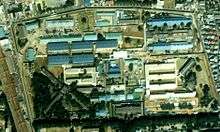300 million yen robbery
The 300 million yen robbery (三億円事件, San Oku En Jiken), also known as the 300 million yen affair or incident, was the single largest heist in Japanese history at the time. It occurred on the morning of December 10, 1968, in Tokyo, Japan. Half a century later, the case remains unsolved.
Robbery

On the morning of December 10, 1968, four Kokubunji branch employees of the Nihon Shintaku Ginko (bank) transported 294,307,500 yen (about US$817,520 at 1968 exchange rates) in the trunk of a company car. The metal boxes contained bonuses for the employees of Toshiba's Fuchu factory. They were stopped in the street next to Tokyo Fuchū Prison by a young uniformed officer on a police motorcycle. The police officer informed them that their branch manager's house had been blown up, and they had received a warning that dynamite had been planted in the transport car. The four employees exited the vehicle while the officer crawled under the car to locate the bomb. Moments later, the employees noticed smoke and flames under the car as the officer rolled out, shouting that it was about to explode. When the employees retreated to the prison walls, the police officer got into the car and drove away.
Investigation
The bank employees believed the thief was a police officer, and accepted his story about the bomb because threatening letters had been sent to the bank manager beforehand. The smoke and flames turned out to be the result of a warning flare he had ignited while under the car. At some point, the thief abandoned the bank's car and transferred the metal boxes to another car, stolen beforehand. That car too was abandoned, and the boxes transferred once again to another previously stolen vehicle.
There were 120 pieces of evidence left at the scene of the crime, including the "police" motorcycle, which had been painted white. However, the evidence was primarily common everyday items, scattered on purpose to confuse the police investigation.
A 19-year-old man, the son of a police officer, was suspected just after the robbery. He died of potassium cyanide poisoning on December 15, 1968. He had no alibi. However, the money was not found at the time of his death. His death was deemed a suicide and he was considered not guilty, according to official record.
A massive police investigation was launched, posting 780,000 montage pictures throughout Japan. The list of suspects included 110,000 names, and 170,000 policemen participated in the investigation — the largest investigation in Japanese history.
On December 12, 1969, a 26-year-old man was suspected by the Mainichi Shimbun. He was arrested on an unrelated charge, but he had an alibi; the robbery occurred on the day he was taking a proctored examination. As the arrest was made based on false pretenses, the arresting police officer, Mitsuo Muto, was accused of abuse of power.
A friend of the 19-year-old suspect was arrested on an unrelated charge on November 15, 1975, just before the statute of limitations. He had a large amount of money and was suspected of the robbery. He was 18 years old when the robbery occurred. The police asked him for an explanation for the large amount of money, but he did not say anything and they were not able to prove that his money had come from the robbery.
The statute of limitations
The seven-year investigation offered few answers, and in December 1975, the statute of limitations on the crime passed without an arrest. As of 1988, the thief has also been relieved of any civil liabilities, allowing him to tell his story without fear of legal repercussions. He has yet to come forward.
See also
- Crime in Japan
- Isabella Stewart Gardner Museum theft, 1990, world's largest art theft from a museum in Boston, U.S., also perpetrated by thieves who disguised themselves as police officers.
References
- Kamiyama, Masuo (1999-02-02). "MEDIA WATCH: Weeklies spar over crime of the century". Asia Times. Retrieved 2006-09-23.
External links